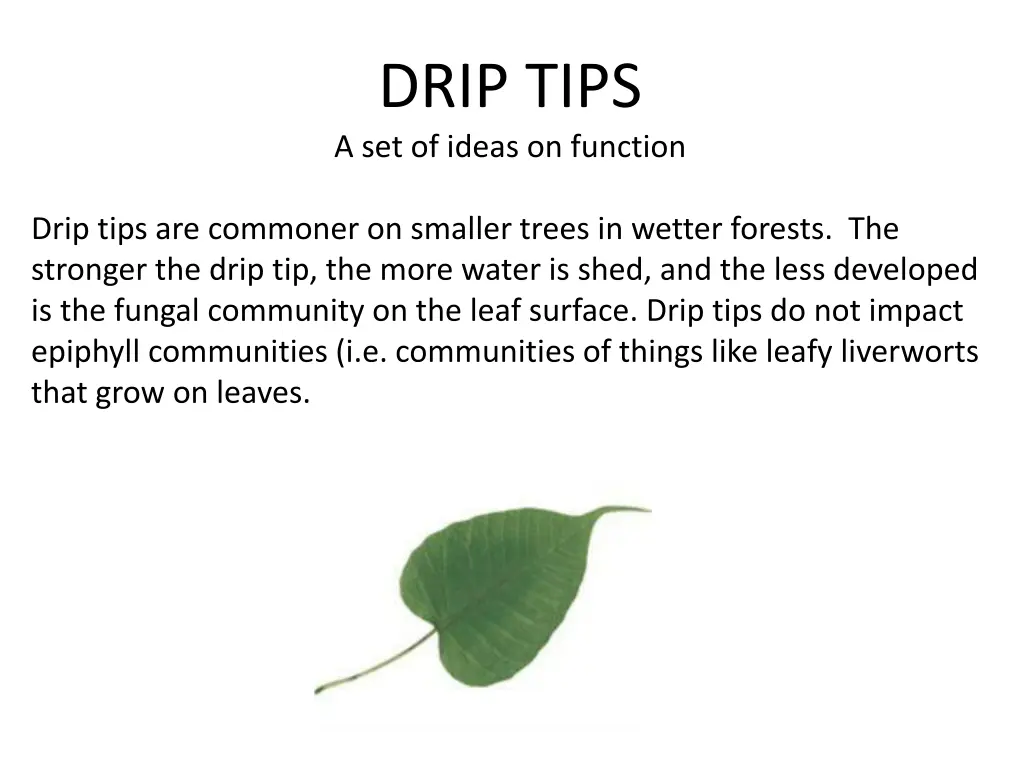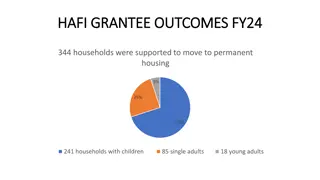
Function of Drip Tips in Rainforest Ecosystems
Explore the role of drip tips in rainforest ecosystems, where these specialized leaf structures facilitate water shedding, impact fungal communities, and are linked to specific tree species. Research suggests that drip tips enhance water flow without reducing epiphyll cover, with implications for leaf surface drying and microbial growth. Dive into the science behind drip tips and their ecological significance in wetter forests, particularly in the Amazon region.
Uploaded on | 0 Views
Download Presentation

Please find below an Image/Link to download the presentation.
The content on the website is provided AS IS for your information and personal use only. It may not be sold, licensed, or shared on other websites without obtaining consent from the author. If you encounter any issues during the download, it is possible that the publisher has removed the file from their server.
You are allowed to download the files provided on this website for personal or commercial use, subject to the condition that they are used lawfully. All files are the property of their respective owners.
The content on the website is provided AS IS for your information and personal use only. It may not be sold, licensed, or shared on other websites without obtaining consent from the author.
E N D
Presentation Transcript
DRIP TIPS A set of ideas on function Drip tips are commoner on smaller trees in wetter forests. The stronger the drip tip, the more water is shed, and the less developed is the fungal community on the leaf surface. Drip tips do not impact epiphyll communities (i.e. communities of things like leafy liverworts that grow on leaves.
1. Trees and species with drip-tips were significantly more prevalent in the Central- East Amazon than the other regions. 2. Drip-tips were also associated with tree species that have smaller maximum heights and with trees with smaller trunk diameters. 3. The proportion of species and individuals with drip-tips was more strongly correlated with precipitation of the wettest trimester than with total annual precipitation or length of the dry season. Malhado, A., Malhi, Y., Whittaker, R.J., Ladle, R.J., Ter Steege, H., Fabr , N.N., Phillips, O., Laurance, W.F., Aragao, L.E., Pitman, N.C. and Ram rez Angulo, H., 2012. Drip tips are Associated with Intensity of Precipitation in the Amazon Rain Forest. Biotropica, 44(6), pp.728- 737.
Drip tips do improve water flow, but not to reducing epiphyll cover: .... drip tips improve the drainage of water from leaf surfaces ... the effect was much more pronounced for Faraniea occidentalis than for Psychotria marginata Note that the latter has a better-developed drip tip. Burd, M., 2007. Adaptive function of drip tips: a test of the epiphyll hypothesis in Psychotria marginata and Faramea occidentalis (Rubiaceae). Journal of Tropical Ecology, 23(04), pp.449-455.
Perhaps the most persistent hypothesis for the function of drip tips is that they facilitate the rapid channeling of water from leaves, which decreases the drying time for the leaf surface (Stahl 1893, Lightbody 1985). i.e. less water is retained, which is correlated with less fungal growth, but not less epiphylls and debris. Interestingly, we observed that epiphylls occurred most frequently on the drier regions of the leaves (away from the midveins, bases, and tips of the leaves), which may indicate that humidity is less of a limiting factor for the establishment of epiphylls than for fungi. Ivey, C.T. and DeSilva, N., 2001. A Test of the Function of Drip Tips1. Biotropica, 33(1), pp.188-191.

![Property Settlements in Family Law: Case Study of Stamatou & Stamatou [2022] FedCFamC1F 241](/thumb/63303/property-settlements-in-family-law-case-study-of-stamatou-stamatou-2022-fedcfamc1f-241.jpg)














